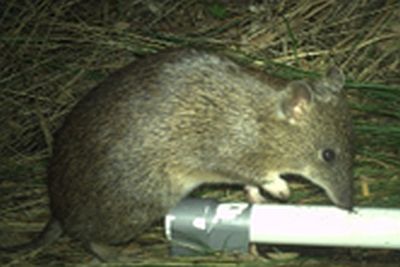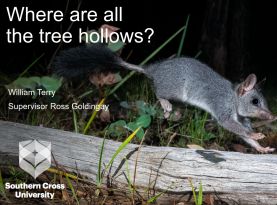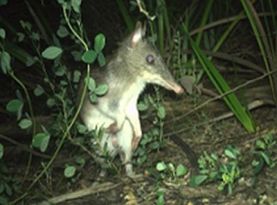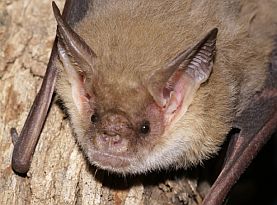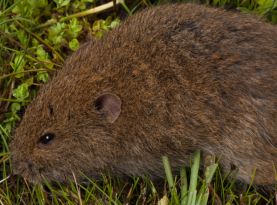SWIFFT Seminar notes 26 May 2022
Small mammal conservation
SWIFFT seminar notes are a summary of the seminar and not intended to be a definitive record of presentations made and issues discussed.
This SWIFFT seminar was conducted online with 237 participants via Microsoft Teams. SWIFFT wishes to acknowledge support from the Department of Environment, Land, Water and Planning, Victoria in organising the seminar and thank speakers for their time and delivery of presentations. Also, thanks to Michelle Butler who chaired the session from Ballarat and acknowledged Traditional owners, Elder’s past and present on the lands covered by the meeting.
Michelle also acknowledged National Sorry Day 26 May, which reminds the colonist-descended people of the nation to remember the mistreatment of Aboriginal and Torres Strait Islander people.
Key points summary
Radio tracked phascogales help identify the key forest resources
European settlement has removed many large old trees which once supported hollows. The creation of new hollows is a slow process taking up to 100 years.
Phascogales were fitted with UHF radio- collar and radio-tracked throughout the year to see what resources they were using in the forest.
Dead trees comprise an important component of phascogale habitat in Central Victoria, with animals spending about 80% of their time using dead trees.
Young phascogales used up to 7.8 hollows per individual whereas older animals tend to use one or two hollows.
Mammal declines and refuges in the Otways
Long-term studies of fauna have been carried out in the Anglesea Heathlands situated in the Eastern Otway Ranges between 1975 - 2007 and again in 2013 – 2022.
The area once had a very healthy small mammal population but suffered a severe decline after the 1983 Ash Wednesday fires.
Re-surveys (2013 to 2020) found a significant decline in small mammals except for the coastal dune system.
Gap-filling threatened species and refuge surveys (June 2021- May 2022) have been able to identify important fauna refuge areas in the Otways.
New insights into the secret lives of bats
Microbats are small insectivorous bats which play an important role in the ecosystem. They consume large amounts of insects, consuming up to half their body weight in insects per night.
Microbats are a diverse group of fauna with 22 species in Victoria. They can be divided into two groups: Cave roosting or Tree roosting using hollows.
Research is being undertaken using innovative methods to monitor the status and ecology of both cave roosting and tree hollow roosting species.
The status of the Broad-toothed Rat in Victoria
The Broad-toothed Rat is unique in that it is the only entirely grass and sedge eating rodent in Victoria.
Grasses/sedges provide an essential part the Broad-toothed Rat ecology, providing food, shelter and a means of moving through the landscape by constructing tunnels through the grass.
Broad-toothed rat scat surveys are now being used to locate and monitor this species.
Fire and slashing of grassy areas not only result in direct loss of grassy habitat but also loss of the tunnel networks which makes this species very susceptible to predation by introduced predators.
List of speakers and topics
Speaker summaries are adapted from presentations and are not intended to be a definitive record of presentations made and issues discussed.
- Where are all the tree hollows? Radio tracked phascogales help identify the key forest resources - William Terry (PhD student - Southern Cross University, Senior Ecology – Arcadis, nature photographer)
- Mammal declines and refuges in the Otways - Dr. Barbara Wilson (Associate Professor - Deakin University, Barbara Wilson Pty Ltd)
- New insights into the secret lives of bats - Dr. Lindy Lumsden (Principal Research Scientist - Arthur Rylah Institute, DELWP)
- The status of the Broad-toothed Rat in Victoria - Sakib Kazi (Zoos Victoria) -
SPEAKER SUMMARIES
Where are all the tree hollows? Radio tracked phascogales help identify the key forest resources
William Terry (PhD student - Southern Cross University, Senior Ecology – Arcadis, nature photographer)
William has a passion for small mammals and has worked in the Natural Resources Management sector for many years, including environmental management at Macedon Ranges Shire. He is currently a Senior Ecologist with Arcadis consulting.
William completed a PhD at Southern Cross University ‘Managing the threatened Brush-tailed Phascogale in the modified landscape of central Victoria’. Supervised by Ross Goldingay Southern Cross University.
Focus of research
- Understanding the potential impact of climate change on small mammals in particular phascogales
- Examining the types of tree hollow resources used by phascogales
- Identifying some potential long-term solutions to the loss of tree hollows for small mammals
Value of tree hollows
William spoke about the fact that tree hollows are an essential part of the Australian environment with over 300 vertebrate species being dependent on hollows.
European settlement has removed large old trees which once supported hollows. The creation of new hollows is a slow process taking up to 100 years. We now have a very depleted resource of hollows across the landscape and especially central Victoria. Even though conservation reserves across central Victoria provide some habitat in the box ironbark forests and woodlands around Bendigo and Castlemaine areas they lack large old trees. William focused on understanding where are small mammals taking refuge in the regenerating forests of central Victoria?
Phascogale require a tree size of at least 80 DBH (Diameter at breast height) (van der Ree et al. 2006)
William pointed out that across his study area large trees with 80 DBH don’t exist as much of the forest is coppice regrowth. The average size of trees used by phascogales across the study sites was 50 DBH.
Study species
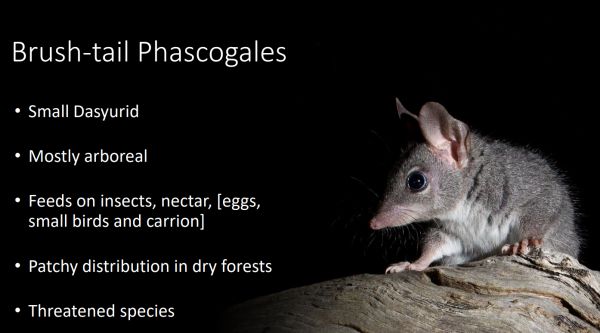
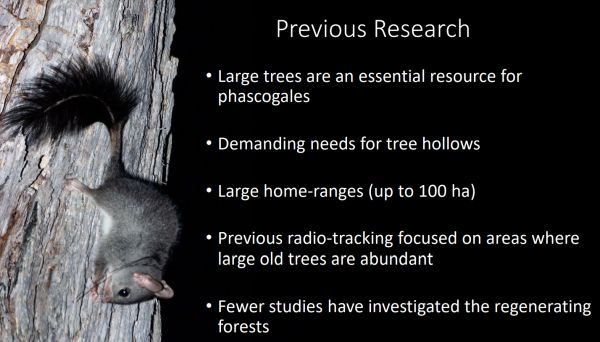
Study area and methods
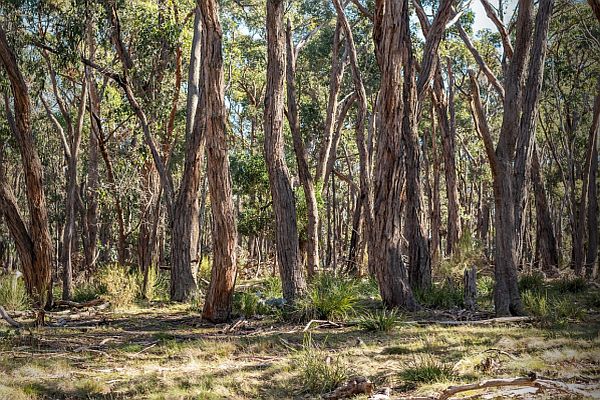
Methods
Phascogales were captured from nest boxes and Elliott traps.
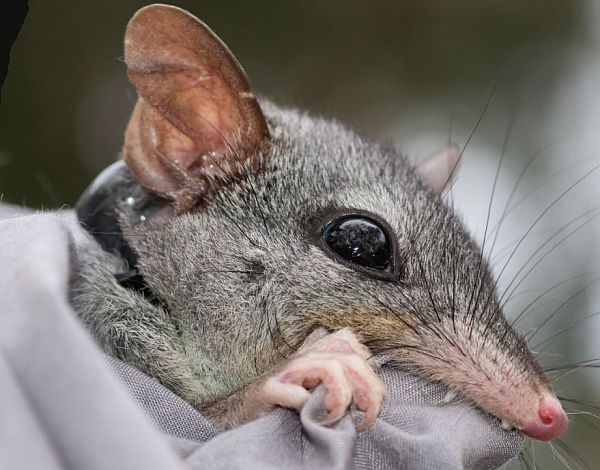
Additional information was recorded such as; diurnal nest tree information, location of tree hollows and dimensions obtained, hollow resources in different habitat areas were also investigated (forest and farming land) and home ranges revisited.
Results
- To date, 29 phascogales collared and tracked (16 females and 13 males)
- 328 fixes of diurnal nest sites
- 88 tree hollows recorded
- 33 nest boxes
- 5 ‘unusual’ nest locations (possum dreys, under tin, house roof, mistletoe)
- 17% (5) of phascogales succumbed to predation (some suspected feral cat)
Home range
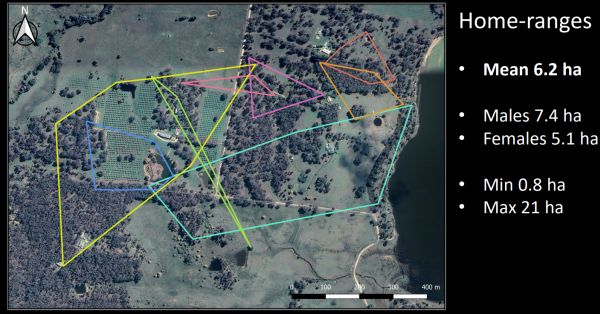
Tracing of phascogales at one of the study sites which has a mix of forest and farmland habitat. William pointed out that the extent of home range can be influenced by the amount of time the animal is tracked. William tracked phascogale for a minimum of 2 months and up to 5 months which is consistent with similar research.
Importance of stag trees
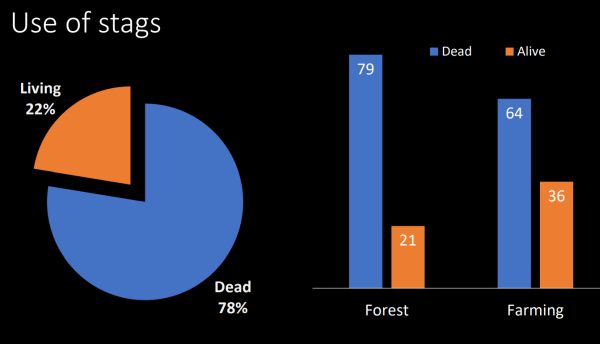
Types of hollows found in the study area
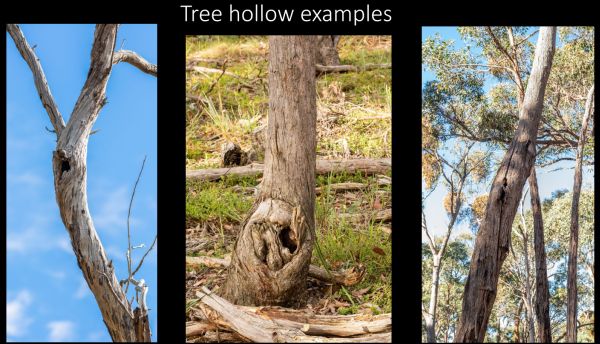
William found that phascogales in the study area use about 7.8 hollows per individual. The type and number of hollows used depends on the stage of their life. Younger animals tend to try out a number of different hollows whereas older animals tend to use one or two hollows.
Threats to phascogale habitat
William discussed the importance of maintaining stag trees which provide essential habitat for phascogales. The problem is that most of these trees are only 20 – 30cm in diameter and are very vulnerable to fire (wildfire or controlled burns) with a high risk of being lost from the landscape.
The loss of dead trees from farmland areas can reduce phascogale habitat. Clearing out dead trees (cleaning up the area) or collection for firewood are both threats to maintaining dead trees in the landscape.
Loss of stags over time is an issue if new stags are not formed to replace decaying stags. William explained that stags in the study area have a life-span around 50 years so we need to ensure that there is ongoing replenishment of stags to sustain habitat for phascogales and small mammals in general.
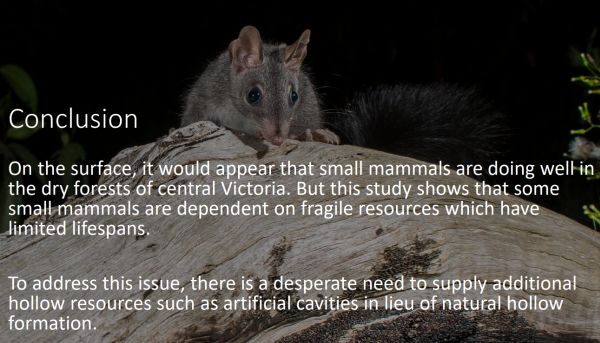
Further activities
William is continuing to collect data through radio tracking phascogales and feels his additional work will only strengthen what he has already found in regard to understanding the importance of dead trees.
William acknowledged a number of individuals and groups who have assisted in the research.
More information
Chainsaw hollows article by William Terry, SCU
Further research publications by William Terry
(van der Ree et al. 2006) Nest-tree selection by the threatened brush-tailed phascogale (Phascogale tapoatafa) (Marsupialia : Dasyuridae) in a highly fragmented agricultural landscape
Key points from questions
- Male phascogales only live to around 11 months of age, females live for about 2 years.
- William has used UHF tracking rather than GPS as it is less expensive and batteries have a longer life. UHF also means he is able to be more precise in locating exactly where the hollow is and in what part of the tree the phascogale is sleeping.
- Nest boxes can be a very useful way of supplementing a lack of natural tree hollows. Chainsaw hollows also provide habitat in larger trees.
- Juvenile phascogales travel about 2-3 km from the nest (results from study area) other studies have found dispersal up to 6 km.
- Phascogales are rarely found in urban or peri-urban areas which have dogs and cats running around.
- Sugar Gliders compete with phascogales for tree hollows, being more dominant in live trees with hollows.
Mammal declines and refuges in the Otways
Dr. Barbara Wilson (Associate Professor - Deakin University, Barbara Wilson Pty Ltd)
Barbara has over 40 years of experience in research and management of Australia’s flora, fauna and terrestrial ecosystems.
Long-term studies
Barbara spoke about the value of long-term studies and the fact that there are very few long-term studies of mammal assemblages in mesic Australia.
Long-term studies have been carried out in the Anglesea Heathlands situated in the Eastern Otway Ranges between 1975- 2007 and again in 2013 - 2022. Much of the research involved looking at reproduction, ecology, impacts of fire, fragmentation, predators, climate change and Phytophthora cinnamomi dieback. In the early 1980’s a focus was to look at the impacts of fire on mammal assemblages. In 1983 the Ash Wednesday fires burnt around 40,000 ha, including a major part of the Otway Ranges so research focused on re-colonisation of species post fire.
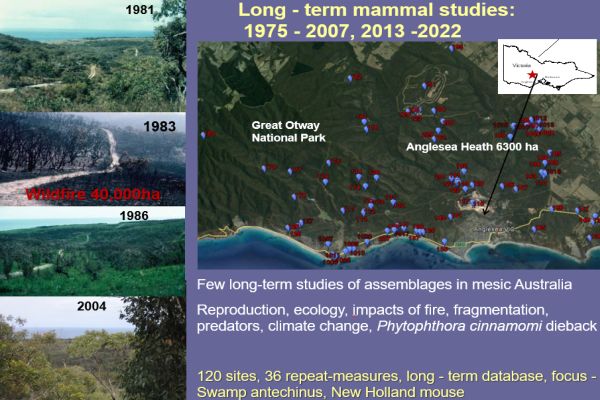
New Holland Mouse was found at 17 sites in woodland, forest containing species rich understorey. The sites had a high-density population in periods of high average rainfall but declined precipitously during drought, noticeably after 2003.
Swamp Antechinus was found at 30 sites in damp, dense heath and woodlands, tussock grass sedgelands. The sites had high-density populations with high average rainfall but extirpated post 1983 wildfire.
Other species with high site occupancy and abundance
- Agile antechinus 61%
- White footed dunnart 61%
- Bush rat 70%
- Swamp rat 61%
Overall, Barbra felt the area had a very healthy small mammal population up to 2007 but re-surveys (2013 to 2020) have found a significant decline in small mammals across the study area.
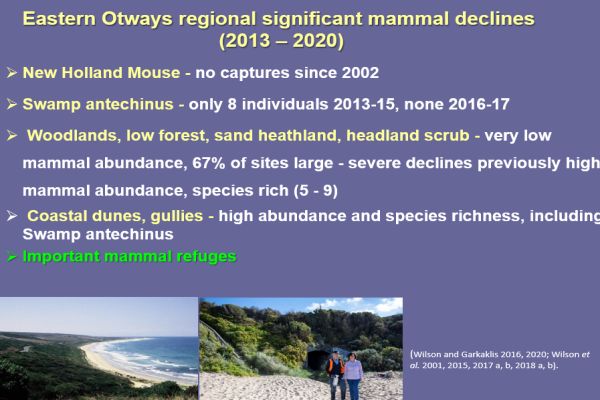
Barbra pointed out the only area to have high abundance of mammals was in the Anglesea to Urquhart’s Bluff coastal dunes which comprise dense, structurally complex vegetation and absence of fire since 1983. This area also has higher nutrients from marine related sources which increases invertebrate production and food for small mammals. The area is optimal for Swamp Antechinus, other species include; Bandicoots, Potoroos and rodents, even in the presence of predators such as foxes and cats.
Wild Otways Initiative 2021-2023 Conserving threatened small mammals in the Otway Ranges
This initiative is Federally funded and managed through the Corangamite CMA and is intended to look at the broader Otway Ranges.
Objectives
1. Maintenance, improvement of threatened mammal species distributions
- Collation of historical and recent EPBCA mammal occurrence data
- Surveys to fill in knowledge gaps of species’ occurrence
2. Maintenance or improvement of threatened species refuges
- Location and current extent of refuges
- Characterise small mammal refuge areas
The studies involved collation, analysis of historical (EPBC) small mammal records to 2021. Data was harvested and audited from databases (VBA, DELWP FFM Victoria), Universities (Uni. Melb, Deakin Uni), Conservation Ecology Centre and individual researchers.
Species total records in Otway Ranges verified from past records
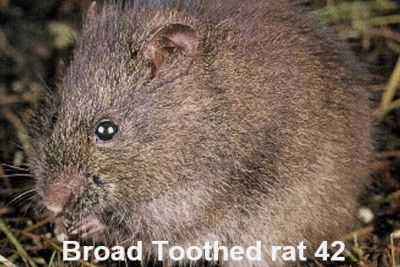
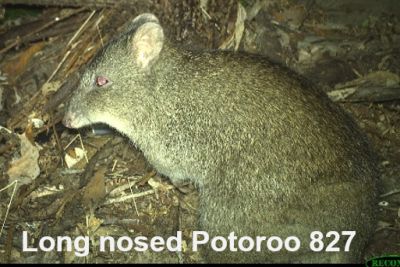
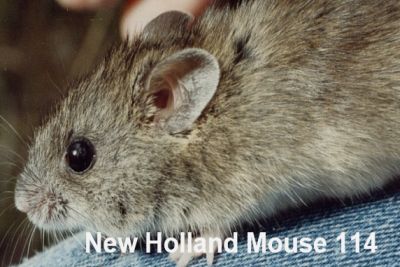
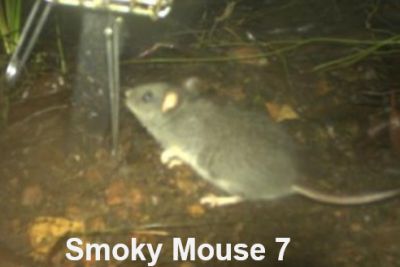
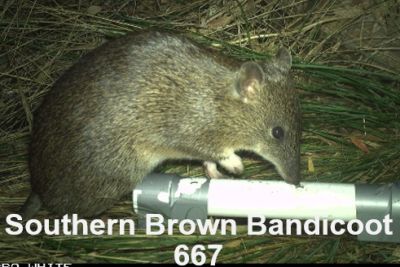
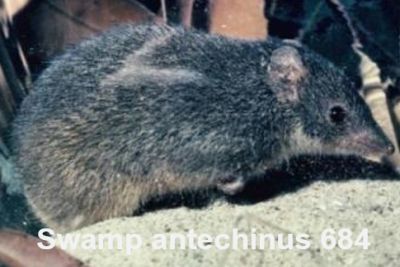
Gap-filling threatened species and refuge surveys (June 2021- May 2022)
Barbara spoke about Gap Surveys which are aimed at determining the current status and distribution of threatened species and mammal refuges. The gap surveys are carried out at notable healthy populations (1975 -2007) in the eastern Otways and locations predicted to be habitat refuges from habitat distribution models.
Surveys include; Camera surveys at more than 225 sites, live trapping at Carlisle Heath (40), Painkalac Valley (10), Currawong Falls (6), Cora/Sharps (6) and Reedy Creek (7). Broad-toothed Rat and Smoky Mouse surveys by Zoos Victoria in April 2022.
Summary Results - Swamp antechinus
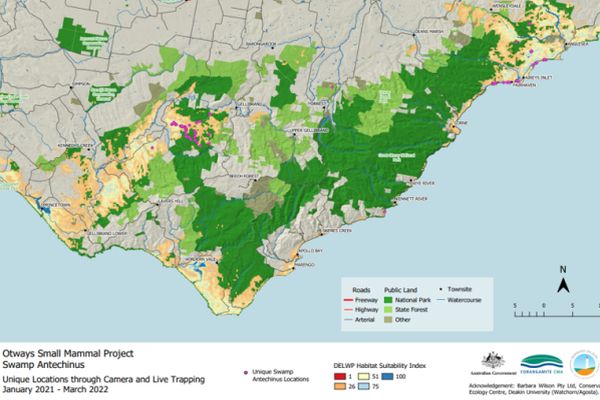
Significant new records regarding Swap Antechinus:
- Painkalac Creek - last recording 2002
- Hutt Gully coastal dunes, gully - last recording 2015
- Urquhart's Bluff coastal headlands, last recording 2007
- Edwards Creek Track gully, last recording 2018
- Carlisle Heathlands
Summary results – Southern Brown Bandicoot
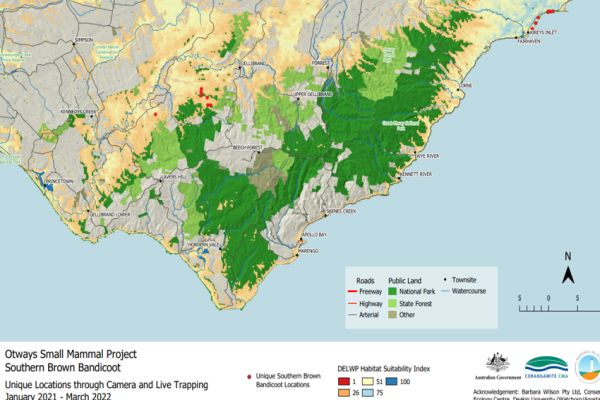
Identifying refuge areas
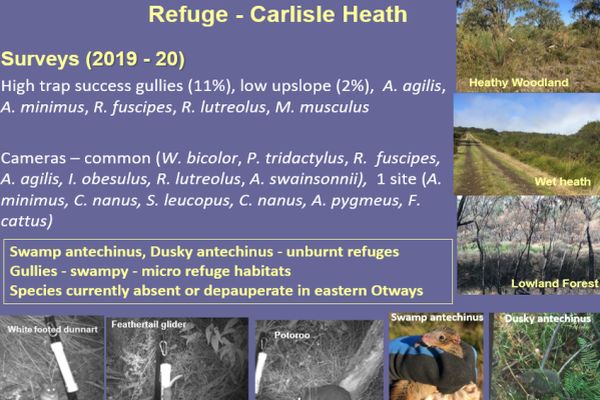
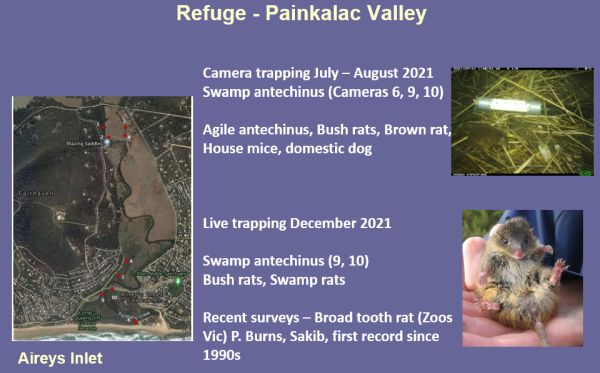
Coastal dune refuges
Existing known refuges have now been extended from the eastern Otways down to Cape Otway.
Management & recovery
Prepare species recovery plans for Otways
- Identify refuges where species and communities remain (The refuges have been mapped in a draft form with the intention of making them available to management agencies responsible for the various land tenure).
- Implement appropriate fire regimes, avoid burning refuges
- Evaluate predator control, manage at local scale - refuges
- Assess captive breeding, reintroduction strategy (New Holland Mouse and Swamp Antechinus)
- Introduce effective P. cinnamommi management
- Implement monitoring to inform adaptive management
Acknowledgements
Barbara thanked all the partners involved in the project over the years, in particular Dr Mark Garkaklis, Deakin University, ARC, and DELWP, Parks Victoria, Barbara Wilson Pty Ltd., Wild Otways Initiative and Corangamite CMA.
Key points from questions
Monitoring Phytophthora cinnamomi in the Anglesea area, including in the mountain bike trail area, however monitoring of fauna needs to be undertaken to assess impacts from the bike trails.
Marine inputs to coastal dunes come from airborne nutrients, marine wrack, dead sea birds and guano from seabirds. The levels of phosphorous are in the order of 10 to 20 times higher than the inland areas.
Cat and fox control is managed through the Otway Ark across the Otways. Barbara felt there is scope to focus predator control to target areas.
New insights into the secret lives of bats
Dr. Lindy Lumsden (Principal Research Scientist - Arthur Rylah Institute, DELWP)
Lindy acknowledged the contribution of fellow researchers at Arthur Rylah Institute in gaining insights into the ecology and management of microbats.
Microbats
Microbats are small insectivorous bats which play an important role in the ecosystem. They consume large amounts of insects, consuming up to half their body weight in insects per night.
Microbats are a diverse group of fauna with 22 species in Victoria. They can be divided into two groups: Cave roosting or Tree roosting using hollows.
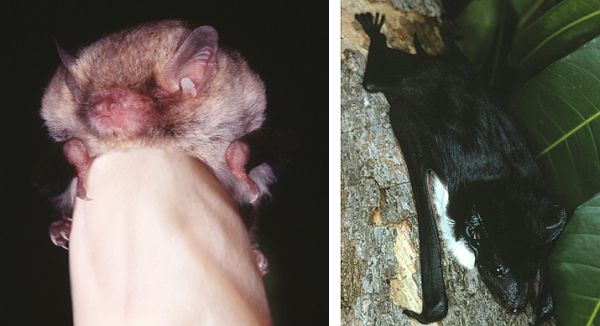
Microbats are not very well understood by most people as they never see them. They are also a difficult group of fauna to study which has led to the development of new and innovative technologies to monitor populations.
Research into a cave roosting species - the Southern Bent-wing Bat
Lindy spoke about research on the Southern Bent-wing Bat which is Critically endangered. It is a cave dwelling species, with only three maternity caves, one in south-eastern South Australia and two caves in southwest Victoria. The Southern Bent-wing Bat has experienced a marked decline in its population over recent decades and further decline is predicted.
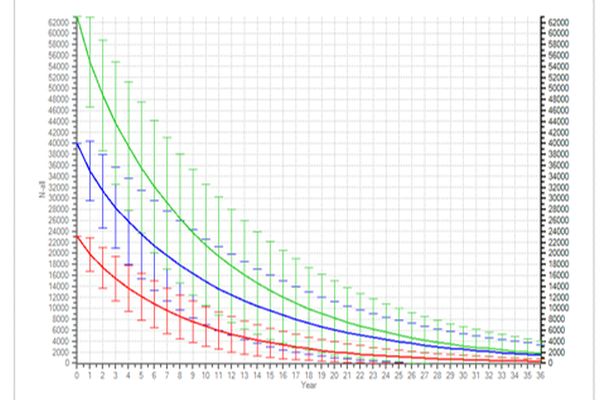
Monitoring
Lindy discussed some of the issues associated with monitoring cave dwelling species such as the Southern Bent-wing Bat. This species does not tolerate disturbance within the cave or the use of white lights.
Thermal cameras and infrared cameras are used in monitoring so as not to cause any disturbance to the bats. Thermal cameras can be used to pick up the heat from the bats as they fly past enabling fly counts. The FLIR Thermal camera can be used with motion tracking software – batTracker to count the numbers of bats leaving and entering the cave to determine accurate population numbers, for example the Warrnambool population is known to have approximately 20,000 individuals.
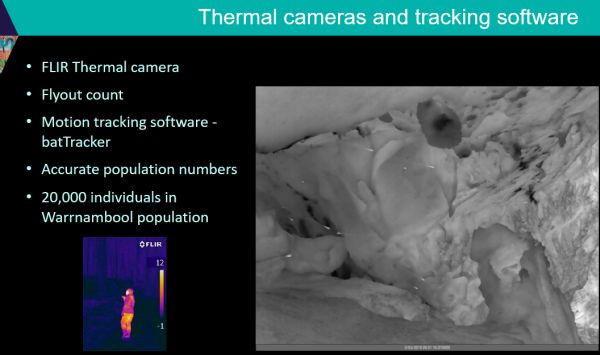
Video adapted from presentation to SWIFFT by Lindy Lumsden, ARI.
After the fly out is over researchers enter the cave and use thermal cameras to locate clusters of pups and any remaining adults, using an infrared camera to locate and and zoom in on clusters using bright infrared illuminators to count bats clustered within the cave. The Southern Bent-wing Bat has a very slow reproductive rate. The most critical stage for survival of lactating females and recently independent young appears to be late summer and early autumn when an abundant supply of food is required.
Findings from the Warrnambool site shows a lower percentage of females are breeding compared with the two other maternity sites.
Southern Bent-wing Bat Recovery Plan and Recovery Team
The Recovery Team is a highly collaborative team comprising a range of people with expertise and different responsibilities, land managers, researchers, State and Federal Government Agencies, cavers, NGO’s.
One of the aims is to address the knowledge gap through researchers undertaking PhD studies:
- Emmi van Harten – population dynamics at Naracoorte
- Amanda Bush – activity and movement patterns
- Nicola Bail – breeding success at Naracoorte
- Ophelie Planckaert – genetic population structure
By undertaking additional research to fill knowledge gaps combined with extensive monitoring of all 3 maternity sites and active management of key roosts it is hoped to prevent extinction of this species.
Research into tree hollow roosting bats
Lindy provided an overview of hollow roosting microbats. In Victoria, there are 18 species of microbats dependent on tree hollows. Dead tree and live trees with hollows are critically important for hollow roosting bats.
The study of hollow roosting bats requires different techniques to cave dwelling bats. Records are mostly obtained where the bats are foraging and based on echolocation calls. Most species calls are in the 25-70 kHz range which is outside human hearing which only goes to about 15 kHz.
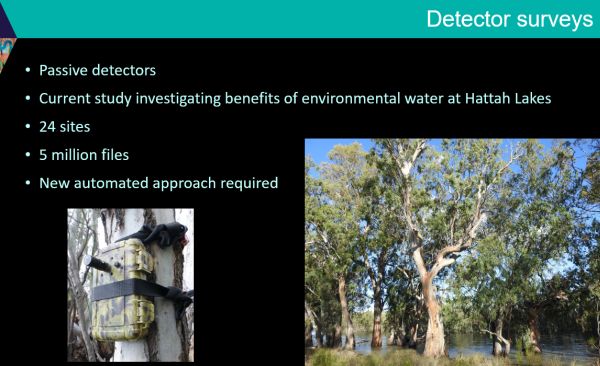
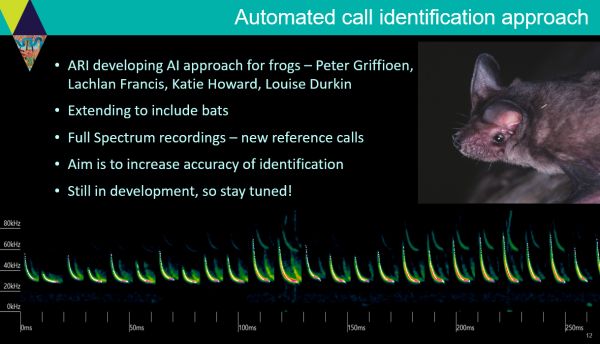
Other monitoring techniques
Lindy pointed out that not all bats can be detected by their calls. Some species have very quiet calls which requires other techniques to find them such as the use of harp traps. Lindy used the example of the Golden-tipped Bat which has only recently been recorded in Victoria. It roosts in hanging bird’s nests and preys on spiders. This species was also found to use mop heads which simulates the type of hanging birds’ nest and provides scope for use of artificial roosting habitat, particularly where forests have been burnt.
South-eastern Long-eared Bat conservation
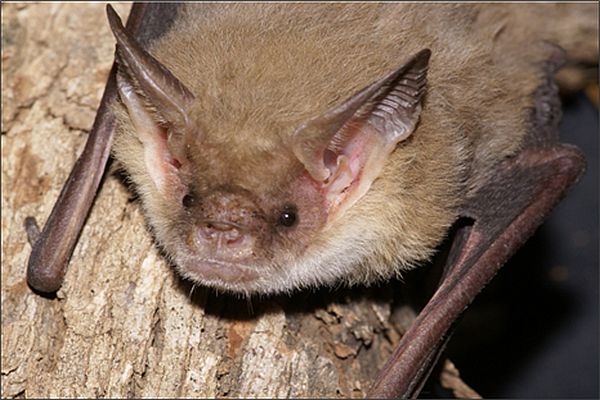
The South-eastern Long-eared Bat is considered endangered in Victoria with only a small number of records across North West Victoria, with most of the recent records, being from Nowingi / Hattah-Kulkyne NP. The species has patchy distribution across the Murray-Darling Basin. Lindy spoke about the possible need for genetic intervention as the populations are quite separate. However, at present there is insufficient knowledge about this species and no population genetic information.
Studies in 2007 – 2010 yielded low capture rates (21 individuals in 3 years). It was found that the species is largely restricted to long-unburnt Mallee habitat and roosts are in large hollow-bearing trees. Lindy revisited the area in 2020/21 to reassess the population status and assess its genetic diversity. There were only 13 captures, some of which were recaptures. All were caught in mist nets with none in the 145 harp trap nights. Genetic samples were taken from 9 individuals and results revealed medium to high genetic diversity which was higher than expected.
Population size estimates were undertaken using mark mark-recapture analysis which estimated the Victorian population could potentially be as low as 22 individuals. Lindy discussed how the findings are counterintuitive. A species with high genetic diversity but low population size. The nearest population is in NSW about 45 km away but separated by unsuitable riverine habitat. It raises the question is the Victorian population in decline or are there other factors at play? Further research is needed to fully understand the genetic health and if genetic rescue is required into the future.
Lindy finished by outlining some practical things that we can all do to help conserve our microbats.
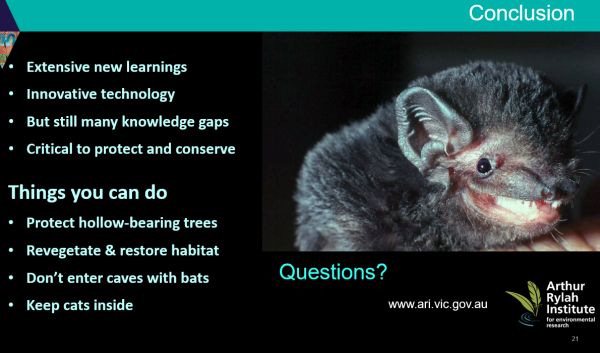
Contact: Lindy Lumsden, Arthur Rylah Institute
Key points from questions
Lindy stressed the importance of tree hollows for microbats, these hollows can be as small as cracks in the tree which are barely visible.
Man-made structures such as old mines, culverts etc. are only used as non-breeding roosts and mainly by the Eastern Bent-wing Bat. Both the Southern and Eastern Bent-wing Bats are highly specific in their use of maternity roosts: there are only three Southern Bent-wing Bat maternity caves, and within Victoria there is only one Eastern Bent-wing Bat maternity cave.
The bat call ID software is still in a development stage and is not ready for release to Citizen Scientists, although the intention is to have it more widely available in the future. In the first instance the use of bat call ID will focus on bat species in Victoria.
Bat boxes can be helpful to supplement tree hollows (Lindy stressed as a supplement not a replacement). One of the main design features is to ensure the material is thick enough to provide thermal insulation. Bat boxes are often dominated by Gould’s Wattled Bats.
More information about bat boxes
The status of the Broad-toothed Rat in Victoria
Sakib Kazi (Zoos Victoria)
Sakib presented in place of Dr. Phoebe Burns (Native Rodent Biologist, Wildlife Conservation and Science who also works with Zoos Victoria).
Sakib introduced his presentation by explaining that in recent years there have been advances in understanding the ecology, distribution and threats of the Broad-toothed Rat.
The Broad-toothed Rat is also known as Tooarrana by the Indigenous people of Tasmania. (CSIRO 1995; Plomley 1976).
Classification
Sakib explained the Broad-toothed Rat Mastacomys fuscus mordicus is currently considered the only member of its genus however further research into phylogenetics (genetic ancestry) has found the species is closely related to Pseudomys genus. This is important because most of the native rodents in Victoria are part of the Pseudomys genus.
Diet
The Broad-toothed Rat is unique in that it is the only rodent in Victoria with a grass- and sedge-based diet, especially grasses in the Poa genus.
Habitat
Grasses provide an essential part the Broad-toothed Rat ecology, providing food, shelter and a means of moving through the landscape by constructing tunnels through the grass. Sakib pointed out that in the high country, which is seasonally covered by snow, the tunnels become an important means by which the animal can move though the landscape beneath the snow. Tunnels are also used in other habitat for example where the species occurs near the coast.
Active tunnels can be detected by closely examining the tunnel to see if there is evidence of grass clippings which the Broad-toothed Rat create as they maintain their tunnels.
Ideal Broad-toothed Rat habitat comprises tussocky poa grasslands with patches of lower branched vegetation which provides additional protection from the elements and predators.
Scat surveys
Sakib spoke about the abundance of scats which can be found in active tunnels. The fresh Broad-toothed Rat scats are quite different to any other small mammal scat as they are bright green in colour (below left), also the old white coloured scats (below right) are uniquely different to other small mammal scats in Victoria, it is only when they in the older stage and brown coloured that they could be confused with Bush Rat scats etc. Sakib pointed out that the Broad-toothed Rat scats are also quite spongey and by breaking open the scat you can see undigested fragments of grass.
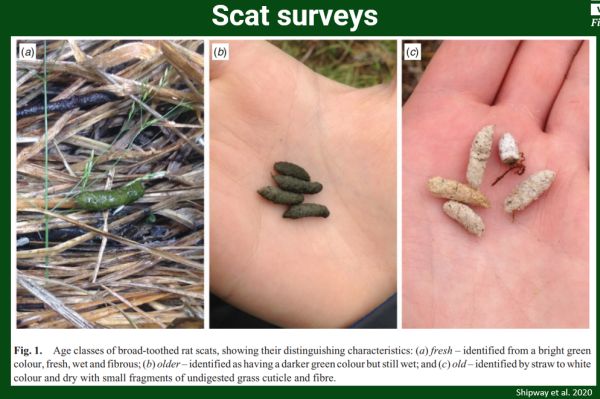
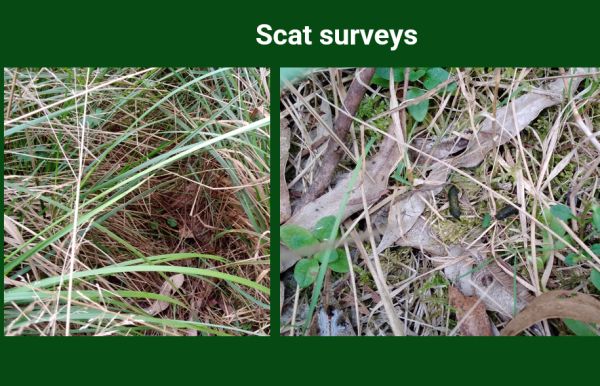
Camera survey
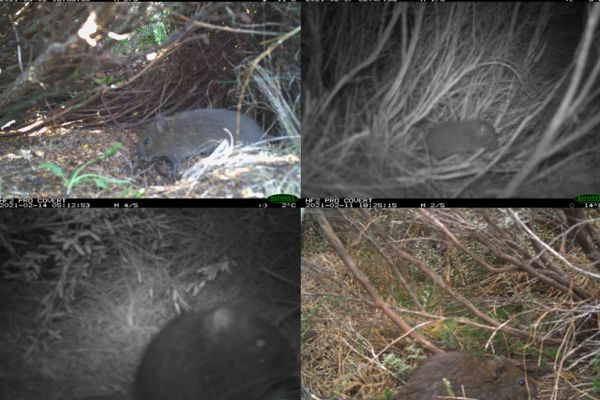
Sub-optimal habitat surveys
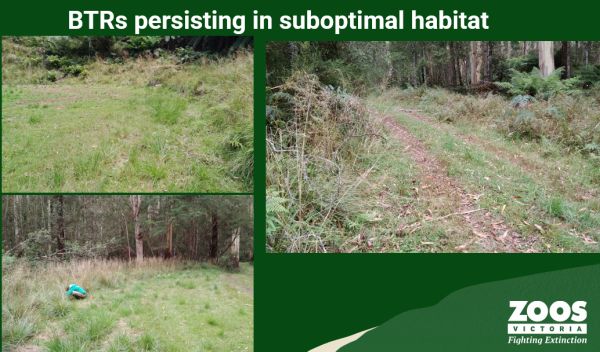
Revisiting the distribution of Broad-toothed Rat in Victoria
Sakib spoke about the need to build up a new picture of where Broad-toothed Rat may occur across Victoria using the scat survey technique. Surveys were conducted in the Otways in April 2022. In four days of surveys the number of records was tripled with many new sites being found.
Threats to the Broad-toothed Rat
In addition to know threats such as fire, more is being understood about how fires impact on the Broad-toothed Rat both in terms of direct loss but also loss of grassy habitat and the tunnel networks. Loss of tunnels makes this species very susceptible to predation by introduced predators.
Unexpected threats which have now become more apparent include; slashing of grassy areas on roadsides and tracks, including fire protection slashing.
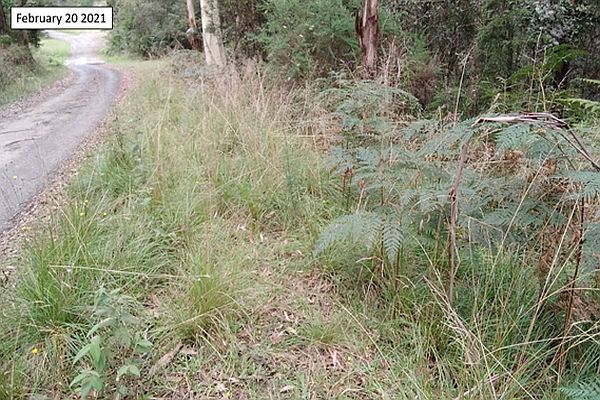
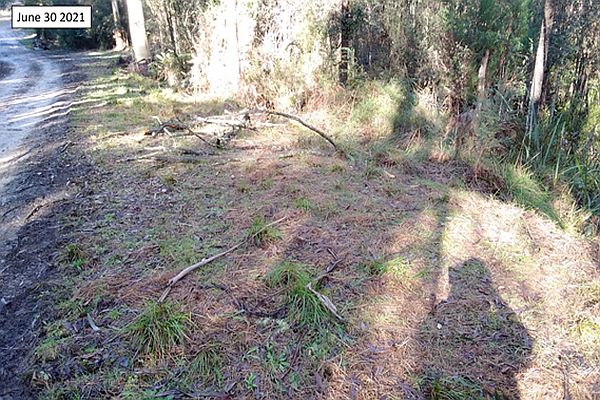
Sakib found a roadside area in the Yarra Ranges which supported Broad-toothed Rats image (left) February 2021 and revisited the site (right) June 30 2021 but found no sign of Broad-toothed Rats being in the area as the habitat had been completely removed. This means track maintenance activities may need to be modified where known populations occur.
Fragmentation occurs when grassy habitat is non-contiguous. Therefore, many populations are isolated from each other by forests, rivers and cleared land. Further studies are being carried out to see if populations are becoming genetically isolated.
A Broad-toothed Rat filmed by Zoos Victoria eating prepared biscuits (Bogong Bikkies) a supplementary food item developed for Mountain-pygmy possums, near Falls Creek, Victoria ). Footage courtesy Zoos Victoria - Fighting extinction. Note the rounded head of this species which is unlike introduced rodents.
Do your own research
Sakib encourages people to undertake scat surveys by identifying the right type of grassy habitat, search for tunnels and scats.
Sakib acknowledged partners in the project including; Zoos Victoria, Parks Victoria, Museums Victoria,WWF, Deakin University, Mt Hotham Resort and Falls Creek resort.
Further reading:
Australian Government - Species profile and threats database - Braod-toothed Rat / Tooarrana
CSIRO (1995) Australian Names for Australian Rodents, (Brathwaite et al. 1995) Australian Nature Conservancy Agency.
Plomley, NJB (1976) A Word List of the Tasmanian Aboriginal Languages.
Notes from previous SWIFFT Seminars


